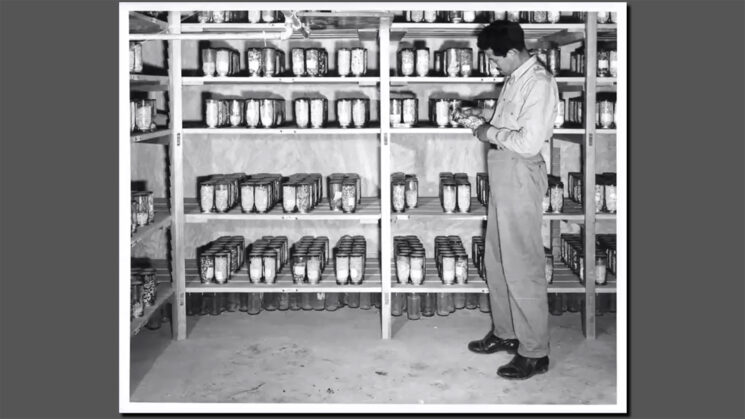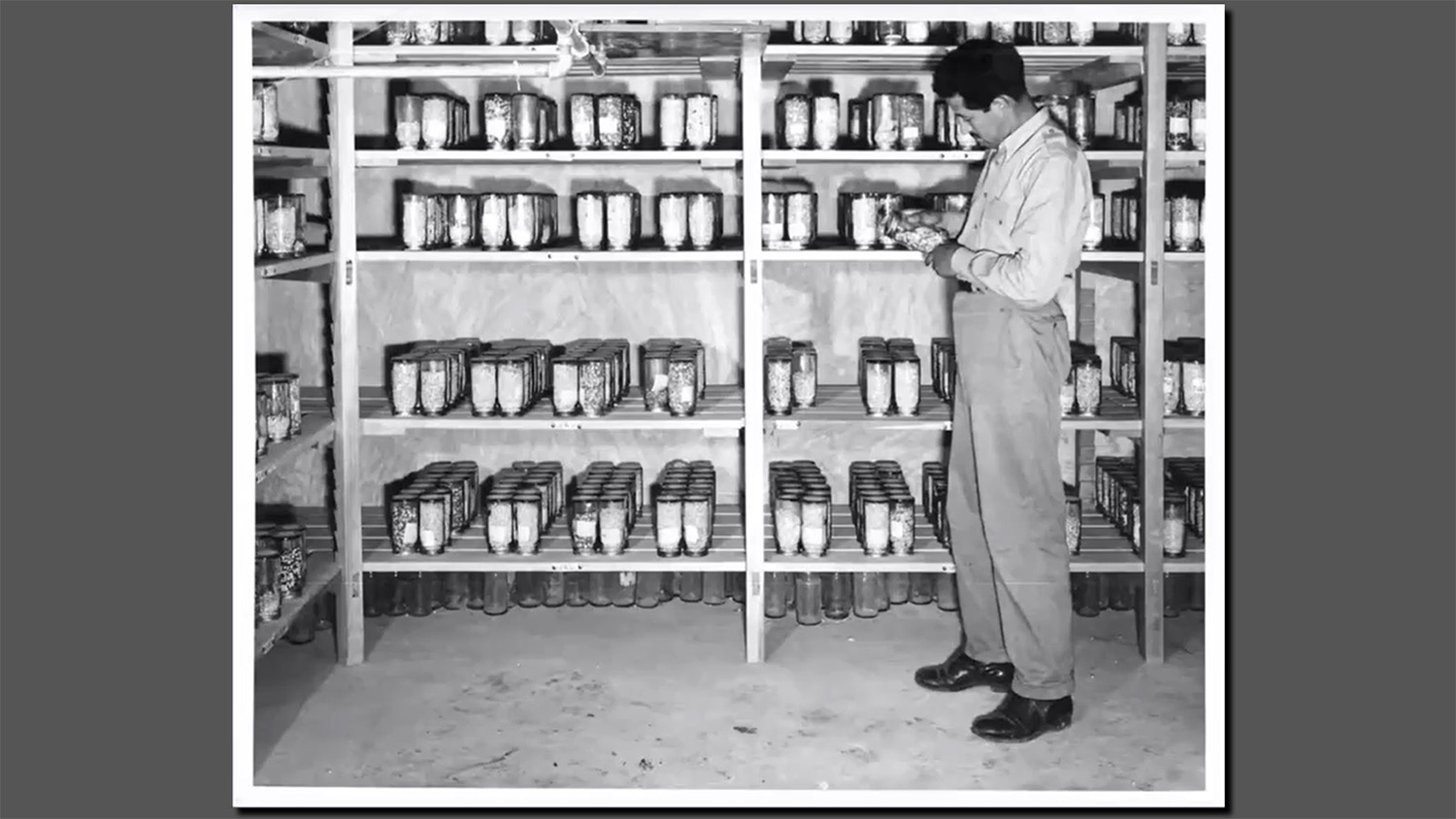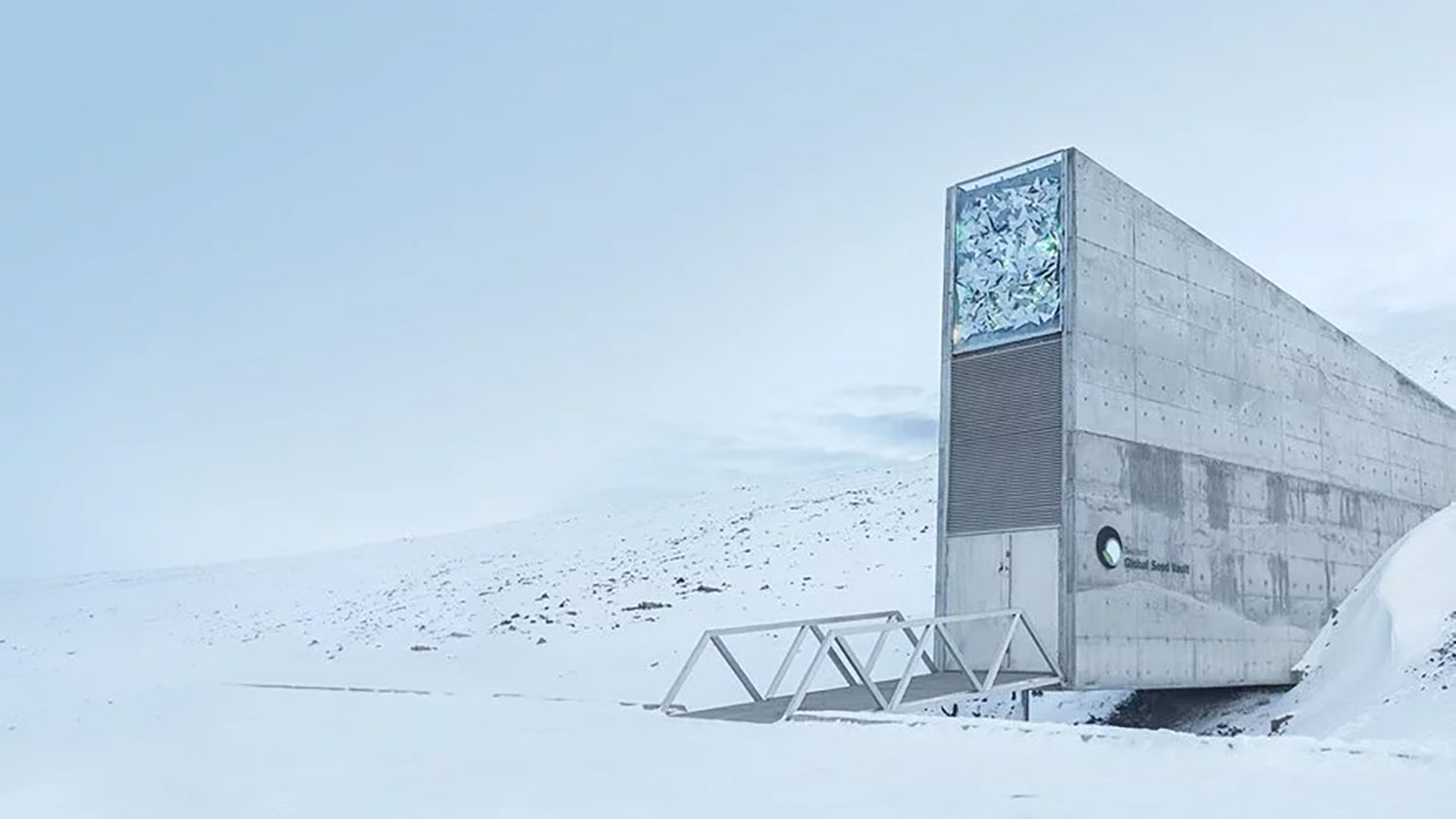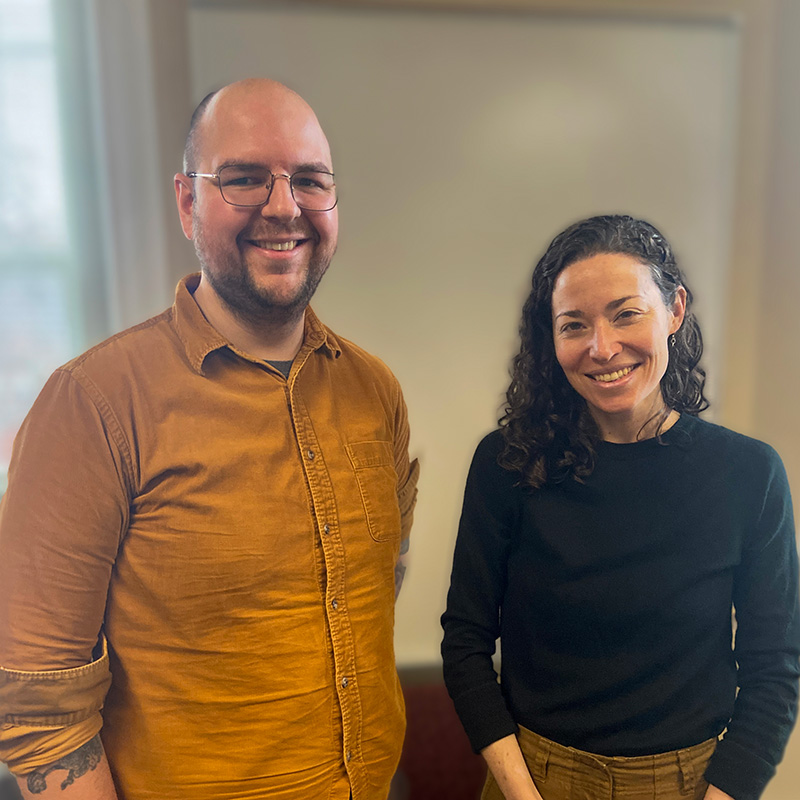
The act of saving a seed holds varied meanings, from my perspective as a molecular biologist, refrigerating seeds for experiments, to the broader perspectives of farmers, breeders, and nations, reflecting the diverse value and conservation methods of seeds, as explored in Dr. Helen Anne Curry’s discussion on seed conservation history and its intersections with scientific, imperialistic, and agricultural narratives.

From Dr. Curry’s presentation, “Corn seed storage,” Mexico,1954. Source: Rockefeller Archive Center, RF Record Group 300D
Written by: Asa Budnick
*Note: The opinions expressed in this article are those of the authors as individuals and should not be taken as a reflection of the views of the whole of the Genetic Engineering and Society Center or NC State University.
What does it mean to save a seed? As a plant molecular biologist, my training has taught me that it means keeping dry seed in a fridge until I want to use it for my next experiment. Farmers, breeders, and nations may all have different answers. Seeds are valuable across many contexts and there are different ways of conserving that value.
At a recent GES Colloquium, Local seeds and global needs: Ethnobotany, agroecology, and the history of in situ conservation of agrobiodiversity (video, podcast), Dr. Helen Anne Curry shared a portion of the history of seed conservation and its entanglement with scientists, imperialism, and narratives of the future of agriculture.
About Helen Anne Curry
Dr. Curry is a professor of the History of Technology in the School of History and Sociology at Georgia Tech. Her work focuses on the history of science and technology, especially in agriculture and she is the PI of Collection to Cultivation – which is a University of Cambridge project to uncover untold stories of how modern agricultural varieties came to be. Dr. Curry is also the author of Endangered Maize: Industrial Agriculture and the Crisis of Extinction and Evolution Made to Order: Plant Breeding and Technological Innovation in Twentieth Century America.
Dr. Curry relayed a story spanning from the late 19th century with the advent of hybrid maize to the modern day. Central to this history is the concept of Genetic Erosion – the idea that the genetic diversity (and accompanying valuable traits) would be lost from farmers’ fields and human understanding as local varieties were abandoned in favor of improved crops from modern breeding efforts. Curry explains that the idea of Genetic Erosion dominated much of the discourse and actions of global north institutions in seed conservation efforts, and ultimately was a misunderstanding and underestimation of farmers. This narrative changed as various fields combined to change the view of farmers from passive recipients of imported varieties to valuable stewards of knowledge and capable decision-makers.
Genetic erosion as a global concern
The advent of hybrid maize was a watershed moment in agriculture. Hybrid corn, corn plants made from breeding two genetically disparate lines together, can be more productive than either of the parental lines in the first generation. However, hybrids rapidly lose this productivity boost across generations meaning saving and replanting hybrid seed isn’t a good option for farmers. This creates the incentive to continuously buy new hybrid seeds each growing season. In the early 20th century the sciences of genetics and breeding were making progress in generating new plant varieties with ‘improved’ characteristics. The value of genetic diversity was deeply appreciated and the converse idea of genetic erosion began to form. Scientists of the time began making calls to conserve the genetic diversity of locally adapted crops – often called landraces- so that they would not be lost as new ‘improved’ lines were released. This movement gained momentum over a few decades and reached a tipping point in the 1960s when the calls received international action.
Anticipating the incipient ‘Green Revolution’ the FAO began to collect, conserve, and use local varieties globally and systematically. This was encouraged by the ‘Green Revolution’ narrative that U.S.-led science was bringing advanced crops to the world and that this was happening not only broadly but rapidly. In the context of genetic erosion, this would lead to the loss of crop diversity if seeds were not actively conserved.

The Svalbard Global Seed Vault stores duplicate copies of most of the crop diversity in the world. Source: CropTrust.org
Broadly, seeds can be saved in situ or ex situ; either in the context of their origin through typical growth and use or in maintained dormancy as seed (for example in a lab refrigerator, or the Svalbard Seed Vault). In the 1960s ex situ seed conservation emerged as the dominant strategy, not only because it was viewed as more practical and economical but also because it was linked to assumptions of agricultural change. In situ seed conservation would cause some farmers to miss out on economic benefits by excluding new varieties to maintain the old. Otto Frankel, the chair of the FAO joint committee on the matter, called in situ seed conservation a social impossibility. Hugh Iltis argued for in situ conservation but said that its long-term success would rely on the exclusion of modern agricultural varieties and technology from seed conservation areas. Both perspectives were based on a shared assumption that inevitable and irrevocable change would be wrought as state, industry, and technology replaced farmers’ varieties. An assumption that didn’t give farmers much consideration or respect.
An international system of ex situ seed conservation was built to serve scientists, particularly breeders, and focused primarily on commodity crops (maize, wheat, rice, etc). This functioned by collecting crop and plant seeds from their local contexts and keeping seeds in dormancy for as long as possible, only growing new plants in controlled conditions to renew seeds. These seed banks were largely inaccessible to publics. Today the FAO estimates that over 1700 ex situ seed banks exist internationally.
Crop diversity as a local resource
Even at the inception of this model, there were alternative groups that pushed back. Alternative agricultural groups, particularly organic farmers, argued that large centralized institutions organizing food banks propped up industrial agricultural systems and focused on creating systems for conservation at the local level. Curry cites two other disciplines that advocated for a more nuanced and accurate understanding of farmers and seeds: ethnobotany and agroecology. Ethnobotany at this time was changing from a discipline focused on reproducing local taxonomies to valorizing local knowledge of plants and ecologies as rich, detailed, and a valid alternative understanding to ‘modern science’. Agroecology was moving from an ecosystems approach to agriculture to advocating for peasant and farmer systems of agriculture by drawing on and producing rich systems of agricultural and ecological knowledge and praxis. Agroecology was also becoming more normative, arguing that these local agroecological systems were not only important but also better than industrial agriculture in key ways.

Southwest Traditional Crop Conservancy Garden and SeedBank, later renamed Native Seed SEARCH. One of their objectives was to exemplify how regional seed banks can serve people, not just provide raw materials for esoteric genetic research. (1981) Source: Curry presentation
In the U.S. Southwest, a new form of ex situ seed saving evolved in the 1970s: the community seed bank. Community seed banks are still largely ex situ in that they are maintaining crops outside of the direct context of their growth and use. However, community seed banks focus on being a community resource and directly foster in situ use and conservation. A local hunger relief charity in Arizona wanted to locate and propagate indigenous food crop seeds as a food source for their community. Gary Nabhan, an ethnobotanist, collaborated with the charity to find these seeds, cultivate them in a conservancy garden, and distribute the food and seeds. This effort and organization became Native Seeds SEARCH. This organization was founded to support Native American farmers, keep diversity extant, and make desert-adapted crops available. In short, this would promote local seed and food security and sovereignty. While the narrative was still one of disappearing crops, nuance was added by acknowledging poverty, discrimination, and loss of lands as causative factors in this disappearance.
Local seeds for global needs
A mission based on serving local interests can also serve broader conservation and scientific goals for crop diversity conservation. To make the case that local-led conservation efforts were capable of doing this the genetic erosion narrative needed to change. This change was facilitated by the inclusion of social scientists in institutional conservation efforts. The same international agricultural institutions which propagated the ex situ seed storage model and centered and propagated industrial agriculture and the ‘Green Revolution’ were also partial sponsors of this change. This change was motivated by critiques that they were serving industrial agriculture and the agendas of the global north by advocating for contextually inappropriate and ineffective crop varieties and management techniques. Part of this problem was that many of the natural scientists employed by these institutions were not seeking an understanding of the needs and contexts of local farmers. To combat this social scientists like anthropologists and sociologists were hired. A key goal was to develop a better understanding of farmers’ practices, needs, and perspectives.
The findings of these social scholars continuously revealed that farmers continued to cultivate traditional varieties and had often added varieties rather than replacing them. This scholarship also revealed a broadly shared culture amongst farmers of continuous experimentation with and exchange of crop varieties. This scholarship found little evidence supporting the genetic erosion narrative. Instead, farmers were balancing priorities of maintenance and ‘progress’ and often adding varieties.
This research suggested that collaboration between farmers and breeders would be more beneficial. These collaborations, broadly termed participatory plant breeding, could aid both in the adoption of new crop varieties and the conservation of local genetic diversity by re-imagining modern breeding in a local context by partnering with farmers. This shift acknowledged that farmers know their own needs and ecologies, and are qualified to make sound decisions. Various institutions trialed participatory plant breeding programs in the late 90s and early 2000s. These programs have achieved a recognized place at the international level though they are still imperfect. Notably participatory plant breeding programs have encountered obstacles with farmer dropout and misaligned incentives between breeders and farmers, though it is overall a step in the right direction for both conservation and generating useful plant varieties.
Ultimately Dr. Curry asserts that the changes in seed conservation efforts have been shifts in scientific and institutional perceptions of people. The recognition of farmer needs, knowledge, and skills is turning them from passive recipients to active collaborators. As Dr. Curry points out the maintenance of crops relies on human action, and the ex situ model removes humanity by focusing on seed shelf-life in cold storage and presuming farmers’ decisions to abandon local varieties to be a foregone conclusion. She says, “I was coming to the understanding that conservation is best understood as being about changing scientific views of people rather than changing views about things.”
Personal perspective

Asa Budnick with Dr. Helen Anne Curry at GES Colloquium on February 27, 2024. Credit: Patti Mulligan
I enjoyed Dr. Curry’s talk and loved the conversation over lunch. I hope for an agricultural future where the needs of people and the environment come first and I believe that local food production will be key to food system reform. As a molecular biologist, it’s not always easy to see how my discipline can contribute to that future, given the intersectionality of food system issues and the way that crop improvement efforts have been conducted over the past century. Dr. Curry’s talk was encouraging to me because it showed that change is happening. I can see part of that change because I am a part of the GES Center which hosts conversations that include people from different disciplines; the types of conversations that I am sure have contributed to the changing perceptions of scientists in Dr. Curry’s talk.
I hope that more diverse and decentralized efforts at food system reform gain ground and that I can be a part of them. I am a molecular biologist and I take seeds from a fridge, sterilize them, and then grow them in a petri dish. I practice esoteric genetics, extracting value from seed by harvesting, sequencing, and analyzing them in hopes of contributing to one form of human knowledge. But this year I have been able to start a garden where I can nurture the value of a seed by planting it in the ground and feeding some of the people I care about.
Helen Anne Curry – Local seeds, global needs, and the history of agrobiodiversity conservation, 2/27/2024Asa Budnick is a Ph.D. Candidate in Plant Biology at NC State and is a member of AgBioFEWS cohort 3. He can be reached at abudnic@ncsu.edu.